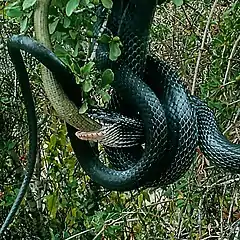Dolichophis jugularis
Dolichophis jugularis, also known commonly as the black whipsnake and the large whip snake, is a species of snake in the family Colubridae. The species is native to West Asia. There are three subspecies.
| Dolichophis jugularis | |
|---|---|
 | |
| Dolichophis jugularis preying on a sheltopusik | |
| Scientific classification | |
| Domain: | Eukaryota |
| Kingdom: | Animalia |
| Phylum: | Chordata |
| Class: | Reptilia |
| Order: | Squamata |
| Suborder: | Serpentes |
| Family: | Colubridae |
| Genus: | Dolichophis |
| Species: | D. jugularis |
| Binomial name | |
| Dolichophis jugularis (Linnaeus, 1758) | |
| Synonyms[2] | |
Geographic range
Dolichophis jugularis is found in Cyprus, Greece, Iran, Iraq, Israel, Jordan, Kuwait, Lebanon, Malta, Syria, and Turkey.[2]
Habitat
D. jugularis is found in a variety of habitats including forest, shrubland, grassland, and freshwater wetlands, at altitudes up to 1,000 m (3,300 ft).[1]
Description
Dorsally, adults are black, but juveniles are tan with darker small blotches. The juvenile pattern disappears when the snake reaches the age of three to four years.[2]
Subspecies
Three subspecies are recognized as being valid, including the nominotypical subspecies.[2]
References
- Baha El Din, S.; Crochet, P.-A.; Hraoui-Bloquet, S.; Kaya, U.; Lymberakis, P.; Disi, A.M.; Sadek, R.; Sevinç, M.; Tok, V.; Ugurtas, I.H.; Werner, Y.L. (2012). "Dolichophis jugularis". IUCN Red List of Threatened Species. 2012: e.T157294A749921. doi:10.2305/IUCN.UK.2012.RLTS.T157294A749921.en. Retrieved 12 November 2021.
- Species Dolichophis jugularis at The Reptile Database www.reptile-database.org.
Further reading
- Arnold EN, Burton JA (1978). A Field Guide to the Reptiles and Amphibians of Britain and Europe. London: Collins. 272 pp. ISBN 0-00-219318-3. (Coluber jugularis, pp. 196–197 + Plate 35 + Map 109).
- Linnaeus C (1758). Systema naturæ per regna tria naturæ, secundum classes, ordines, genera, species, cum characteribus, differentiis, synonymis, locis. Tomus I. Editio Decima, Reformata. Stockholm: L. Salvius. 824 pp. (Coluber jugularis, new species, p. 225). (in Latin).
This article is issued from Wikipedia. The text is licensed under Creative Commons - Attribution - Sharealike. Additional terms may apply for the media files.
